|

On eBay Now...
Six Kinds of Beneficial Insect Specimen Set in clear block Teaching Aid For Sale
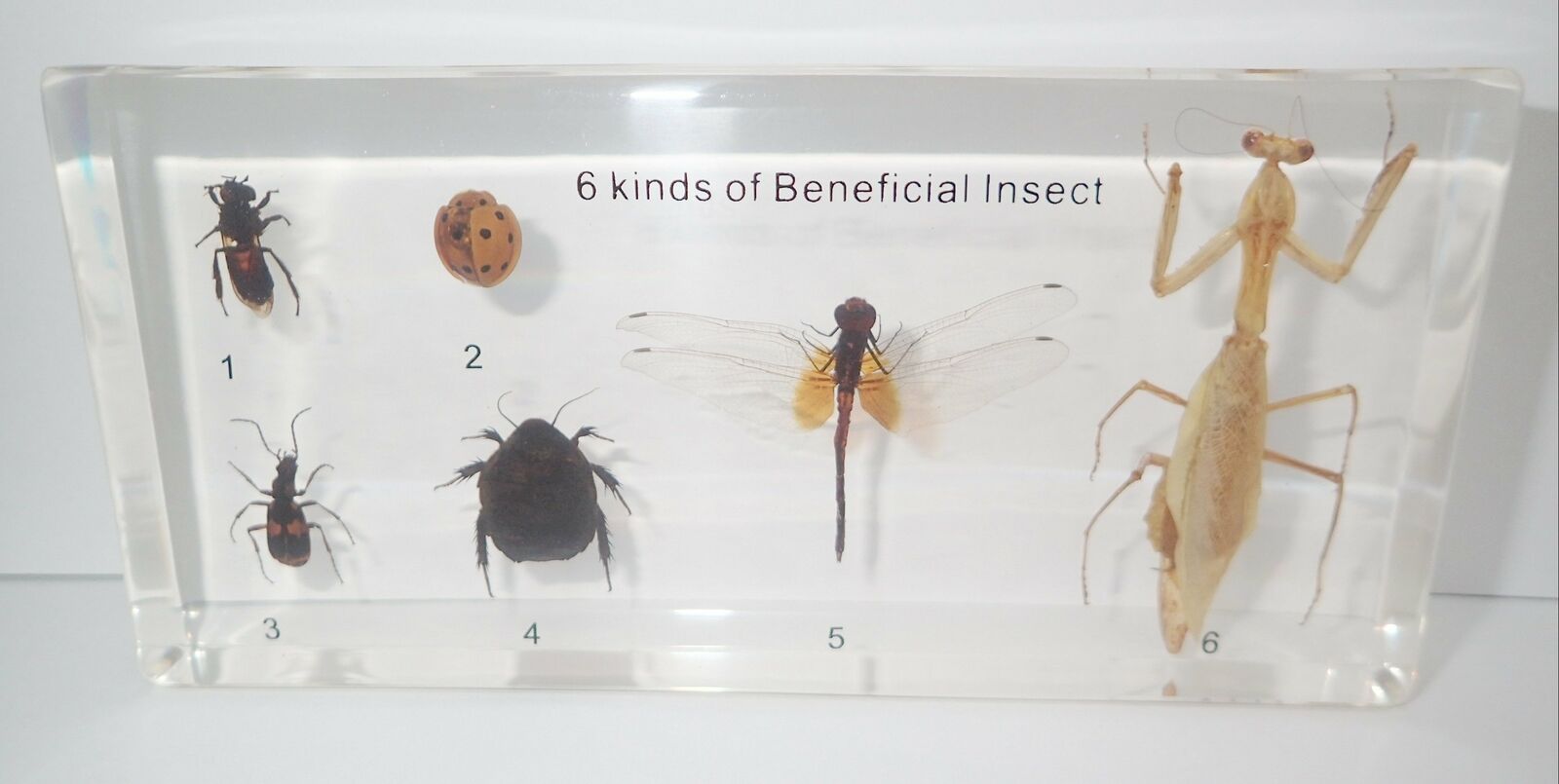
When you click on links to various merchants on this site and make a purchase, this can result in this site earning a commission. Affiliate programs and affiliations include, but are not limited to, the eBay Partner Network.

Six Kinds of Beneficial Insect Specimen Set in clear block Teaching Aid:
$38.00
Six Kinds of Beneficial Insect Specimen SetReal Honey Bee (Apis mellifera), 13 Star Golden Ladybird Beetle - Synonycha grandis, Spotted Brownish Ground Beetle – Pheropsophus jessoensis, Turtle Cockroach - Eupolyphaga sinensis, Dragonfly Scarlet Skimmer - Crocothemis servilia and Praying Mantis - paratenodera sinensis specimens encased in clear lucite material. The specimen is crystal clear, indestructible and transparent. Safe, authentic and completely unbreakable product put real specimens right at your fingertips! Anyone can safely explore the specimens from every angle. It is clear enough for microscope observation. The Nature Garden Six Kinds of Beneficial Insect Specimen Set in clear block Teaching Aid
Six Kinds of Beneficial Insect Specimen Set Real Honey Bee (Apis mellifera), 13 Star Golden Ladybird Beetle - Synonycha grandis, Spotted Brownish Ground Beetle – Pheropsophus jessoensis, Turtle Cockroach - Eupolyphaga sinensis, Dragonfly Scarlet Skimmer - Crocothemis servilia and Praying Mantis - paratenodera sinensis specimens encased in clear lucite material. The specimen is crystal clear, indestructible and transparent. Safe, authentic and completely unbreakable product put real specimens right at your fingertips! Anyone can safely explore the specimens from every angle. It is clear enough for microscope observation. Size of thelucite block is 16.5x7.8x2.5 cm(6.5x3.1x1.0 inch). Each one comes with a cardboard box for easy storage.
Weight of thelucite block is300 g and500 g with packing box.
1:Honey Bee 2:13 Star Golden Ladybird Beetle3:Spotted Brownish Ground Beetle 4: Turtle Cockroach 5: Dragonfly Scarlet Skimmer 6: Praying Mantis This is a handmade real animal specimen craft. Each one will be a bit different (specimen size, color and posture) even in the same production batch.
The pictures in the listing are just for reference as we are selling multiple pieces with same pictures.
It is an ideal learning aid for students and kids and also a very good collectible item for every body. *** Honey Bee - Apis mellifera The Western honey bee or European honey bee (Apis mellifera) is a species of honey bee. This species was introduced to China from early 20th century and has been raised widely around the country. In the temperate zone, honey bees survive winter as a colony, and the queen begins egg laying in mid to late winter, to prepare for spring. This is most likely triggered by longer day length. She is the only fertile female, and deposits all the eggs from which the other bees are produced. Except a brief mating period when she may make several flights to mate with drones, or if she leaves in later life with a swarm to establish a new colony, the queen rarely leaves the hive after the larvae have become full grown bees. The queen deposits each egg in a cell prepared by the worker bees. The egg hatches into a small larva which is fed by nurse bees (worker bees who maintain the interior of the colony). After about a week, the larva is sealed up in its cell by the nurse bees and begins the pupal stage. After another week, it will emerge an adult bee. For the first ten days of their lives, the female worker bees clean the hive and feed the larvae. After this, they begin building comb cells. On days 16 through 20, a worker receives nectar and pollen from older workers and stores it. After the 20th day, a worker leaves the hive and spends the remainder of its life as a forager. The population of a healthy hive in mid-summer can average between 40,000 and 80,000 bees. 13 Star Golden Ladybird Beetle - Synonycha grandis Order ColeopteraLinnaeus, 1758 -- beetles, besouro, coléoptères Suborder PolyphagaEmery, 1886 Infraorder CucujiformiaLameere, 1938 Superfamily CucujoideaLatreille, 1802 Family CoccinellidaeLatreille, 1807 -- coccinelles, ladybird beetles Subfamily CoccinellinaeLatreille, 1807 Genus SynonychaChevrolat in Dejean, 1837 Species Synonycha grandis(Thunberg, 1781) Coccinellidae is a family of beetles, known variously as ladybirds (British English, Australian English, South African English), ladybugs (North American English) or lady beetles (preferred by some scientists). The family name comes from its type genus, Coccinella. Coccinellids are found worldwide, with over 5,000 species described, more than 450 native to North America alone. Coccinellids are small insects, ranging from 1 mm to 10 mm (0.04 to 0.4 inches), and are commonly yellow, orange, or scarlet with small black spots on their wing covers, with black legs, head and antennae. A very large number of species are mostly or entirely black, gray, or brown, however, and may be difficult for non-entomologists to recognize as coccinellids (and, conversely, there are many small beetles that are easily mistaken as such, like tortoise beetles). They are generally considered useful insects as many species feed on aphids or scale insects, which are pests in gardens, agricultural fields, orchards, and similar places. Some people consider seeing them or having them land on one's body to be a sign of good luck to come, and that killing them presages bad luck. A few species are pests in North America and Brownish Ground Beetle – Pheropsophus jessoensis Distribution: China, Japan, Korea Body size: 15 - 22 mm Description: When the insect is attacked by enemy, it blast off
poisen gas and explosion from the end of abdomen. Feature
The adult body is yellow-brown mottling, and the longitudinal muscle sheath to Article 9. Most of the class is black ground beetle and a series of monochromatic colors of the body in a few gaudy colors, and the relatively large stature (about 1.6 cm), very noticeable presence. Catch the abdomen and back-end noise from the glitz of the gas blowout. Hokkaido distribution in the Japanese archipelago from Amami Oshima. China and the Korean Peninsula in the continental distribution. Turtle Cockroach - Eupolyphaga sinensis Order: Blattodea Family: Corydiidae Genus: Eupolyphaga Species: E. sinensis Distribution: China, Mongolia Flat oval, length 1.3 ~ 3cm, width 1.2 ~ 2.4cm. The narrow front end, back-end wide, back, purple, brown, glossy, wingless. Pronotum more developed to cover the head; front and plate 9, showing imbricate. Ventral surface reddish brown, the head small, filamentous tentacles 1 pairs, often fall off, the chest full three pairs, with fine hairs and thorns. Abdominal cross-links. Quality crisp, fragile. Gas stench, the taste slightly salty. Scarlet Skimmer - Crocothemis servilia Order: ODONATA Family: LIBELLULIDAE Genus: Crocothemis Crocothemis servilia is one of the most common and widespread odonate species in the world, occurring in artificial and highly disturbed habitats and under no threats at present. Crocothemis servilia is an extremely widespread species, occurring throughout mainland tropical and subtropical Asia, Japan, the Ryukyu Archipelago, the greater and lesser Sunda isles, the Philippines and Sulawesi. In the west it extends into Iraq, Iran, Armenia and Turkey. It has been accidentally introduced into Florida in the USA. The Scarlet Skimmer (Crocothemis servilia) is a species native to Asia which was introduced to southern Florida. It was first discovered in the U.S. near Miami, Florida, in 1975 and since has become common across most of the southern half of the Florida peninsula. This species breeds in ponds, ditches, marshes and open swamps. This species does not appear to be under any major threats across most of its range. Male body is red color and female body is yellow in color. Praying Mantis - paratenodera sinensis Mantis refers to any of various predatory long-bodied large-eyed insects of the family Mantidae, primarily tropical but including a few temperate zone species, usually pale green and having two pairs of walking legs and powerful grasping forelimbs. The mantis feeds on live insects, including others of its own kind. Mantis refers to any of various predatory long-bodied large-eyed insects of the family Mantidae, primarily tropical but including a few temperate zone species, usually pale green and having two pairs of walking legs and powerful grasping forelimbs. The mantis feeds on live insects, including others of its own kind.
Although the female mantis has the habit of eating the male after mating, its name suggests a more benign activity. Mantis is from the Greek word mantis, meaning ¡§prophet, seer.¡¨ The Greeks, who made the connection between the upraised front legs of a mantis waiting for its prey and the hands of a prophet in prayer, used the name mantis to mean ¡§the praying mantis.¡¨ This word and sense were picked up in modern Latin and from there came into English, being first recorded in 1658. Once we know the origin of the term mantis, we realize that the species names praying mantis and Mantis religiosa are a bit redundant.
Item SpecificsMaterial :ResinType :Collector PlateCountry of Manufacture :ChinaCountry/Region of Manufacture :ChinaUPC :Does not applyModified Item :NoHandmade :Yes
Payment By Paypal Shipping Free shipping cost. We send the goods to USA, Canada, UK, Australia, New Zealand, EU countries and some other European and Asian countries by E-express, a kind of fast postal service by Hong Kong Post. It usually takes about 6 to 10 working days for delivery. We send the goods to other countries by registered airmail and will take about 8 to 14 working days for delivery. Returns Returns: We accept returns with any reason in 30 days. Contact Us We will answer buyer messages within 24 hours during working days. The Nature Garden From all around the world DESCRIPTIONPAYMENTSHIPPINGRETURN POLICYCONTACT US Six Kinds of Beneficial Insect Specimen Set in clear block Teaching Aid
Six Kinds of Beneficial Insect Specimen Set Real Honey Bee (Apis mellifera), 13 Star Golden Ladybird Beetle - Synonycha grandis, Spotted Brownish Ground Beetle – Pheropsophus jessoensis, Turtle Cockroach - Eupolyphaga sinensis, Dragonfly Scarlet Skimmer - Crocothemis servilia and Praying Mantis - paratenodera sinensis specimens encased in clear lucite material. The specimen is crystal clear, indestructible and transparent. Safe, authentic and completely unbreakable product put real specimens right at your fingertips! Anyone can safely explore the specimens from every angle. It is clear enough for microscope observation. Size of thelucite block is 16.5x7.8x2.5 cm(6.5x3.1x1.0 inch). Each one comes with a cardboard box for easy storage.
Weight of thelucite block is300 g and500 g with packing box.
1:Honey Bee 2:13 Star Golden Ladybird Beetle3:Spotted Brownish Ground Beetle 4: Turtle Cockroach 5: Dragonfly Scarlet Skimmer 6: Praying Mantis This is a handmade real animal specimen craft. Each one will be a bit different (specimen size, color and posture) even in the same production batch.
The pictures in the listing are just for reference as we are selling multiple pieces with same pictures.
It is an ideal learning aid for students and kids and also a very good collectible item for every body. *** Honey Bee - Apis mellifera The Western honey bee or European honey bee (Apis mellifera) is a species of honey bee. This species was introduced to China from early 20th century and has been raised widely around the country. In the temperate zone, honey bees survive winter as a colony, and the queen begins egg laying in mid to late winter, to prepare for spring. This is most likely triggered by longer day length. She is the only fertile female, and deposits all the eggs from which the other bees are produced. Except a brief mating period when she may make several flights to mate with drones, or if she leaves in later life with a swarm to establish a new colony, the queen rarely leaves the hive after the larvae have become full grown bees. The queen deposits each egg in a cell prepared by the worker bees. The egg hatches into a small larva which is fed by nurse bees (worker bees who maintain the interior of the colony). After about a week, the larva is sealed up in its cell by the nurse bees and begins the pupal stage. After another week, it will emerge an adult bee. For the first ten days of their lives, the female worker bees clean the hive and feed the larvae. After this, they begin building comb cells. On days 16 through 20, a worker receives nectar and pollen from older workers and stores it. After the 20th day, a worker leaves the hive and spends the remainder of its life as a forager. The population of a healthy hive in mid-summer can average between 40,000 and 80,000 bees. 13 Star Golden Ladybird Beetle - Synonycha grandis Order ColeopteraLinnaeus, 1758 -- beetles, besouro, coléoptères Suborder PolyphagaEmery, 1886 Infraorder CucujiformiaLameere, 1938 Superfamily CucujoideaLatreille, 1802 Family CoccinellidaeLatreille, 1807 -- coccinelles, ladybird beetles Subfamily CoccinellinaeLatreille, 1807 Genus SynonychaChevrolat in Dejean, 1837 Species Synonycha grandis(Thunberg, 1781) Coccinellidae is a family of beetles, known variously as ladybirds (British English, Australian English, South African English), ladybugs (North American English) or lady beetles (preferred by some scientists). The family name comes from its type genus, Coccinella. Coccinellids are found worldwide, with over 5,000 species described, more than 450 native to North America alone. Coccinellids are small insects, ranging from 1 mm to 10 mm (0.04 to 0.4 inches), and are commonly yellow, orange, or scarlet with small black spots on their wing covers, with black legs, head and antennae. A very large number of species are mostly or entirely black, gray, or brown, however, and may be difficult for non-entomologists to recognize as coccinellids (and, conversely, there are many small beetles that are easily mistaken as such, like tortoise beetles). They are generally considered useful insects as many species feed on aphids or scale insects, which are pests in gardens, agricultural fields, orchards, and similar places. Some people consider seeing them or having them land on one's body to be a sign of good luck to come, and that killing them presages bad luck. A few species are pests in North America and Brownish Ground Beetle – Pheropsophus jessoensis Distribution: China, Japan, Korea Body size: 15 - 22 mm Description: When the insect is attacked by enemy, it blast off
poisen gas and explosion from the end of abdomen. Feature
The adult body is yellow-brown mottling, and the longitudinal muscle sheath to Article 9. Most of the class is black ground beetle and a series of monochromatic colors of the body in a few gaudy colors, and the relatively large stature (about 1.6 cm), very noticeable presence. Catch the abdomen and back-end noise from the glitz of the gas blowout. Hokkaido distribution in the Japanese archipelago from Amami Oshima. China and the Korean Peninsula in the continental distribution. Turtle Cockroach - Eupolyphaga sinensis Order: Blattodea Family: Corydiidae Genus: Eupolyphaga Species: E. sinensis Distribution: China, Mongolia Flat oval, length 1.3 ~ 3cm, width 1.2 ~ 2.4cm. The narrow front end, back-end wide, back, purple, brown, glossy, wingless. Pronotum more developed to cover the head; front and plate 9, showing imbricate. Ventral surface reddish brown, the head small, filamentous tentacles 1 pairs, often fall off, the chest full three pairs, with fine hairs and thorns. Abdominal cross-links. Quality crisp, fragile. Gas stench, the taste slightly salty. Scarlet Skimmer - Crocothemis servilia Order: ODONATA Family: LIBELLULIDAE Genus: Crocothemis Crocothemis servilia is one of the most common and widespread odonate species in the world, occurring in artificial and highly disturbed habitats and under no threats at present. Crocothemis servilia is an extremely widespread species, occurring throughout mainland tropical and subtropical Asia, Japan, the Ryukyu Archipelago, the greater and lesser Sunda isles, the Philippines and Sulawesi. In the west it extends into Iraq, Iran, Armenia and Turkey. It has been accidentally introduced into Florida in the USA. The Scarlet Skimmer (Crocothemis servilia) is a species native to Asia which was introduced to southern Florida. It was first discovered in the U.S. near Miami, Florida, in 1975 and since has become common across most of the southern half of the Florida peninsula. This species breeds in ponds, ditches, marshes and open swamps. This species does not appear to be under any major threats across most of its range. Male body is red color and female body is yellow in color. Praying Mantis - paratenodera sinensis Mantis refers to any of various predatory long-bodied large-eyed insects of the family Mantidae, primarily tropical but including a few temperate zone species, usually pale green and having two pairs of walking legs and powerful grasping forelimbs. The mantis feeds on live insects, including others of its own kind. Mantis refers to any of various predatory long-bodied large-eyed insects of the family Mantidae, primarily tropical but including a few temperate zone species, usually pale green and having two pairs of walking legs and powerful grasping forelimbs. The mantis feeds on live insects, including others of its own kind.
Although the female mantis has the habit of eating the male after mating, its name suggests a more benign activity. Mantis is from the Greek word mantis, meaning ¡§prophet, seer.¡¨ The Greeks, who made the connection between the upraised front legs of a mantis waiting for its prey and the hands of a prophet in prayer, used the name mantis to mean ¡§the praying mantis.¡¨ This word and sense were picked up in modern Latin and from there came into English, being first recorded in 1658. Once we know the origin of the term mantis, we realize that the species names praying mantis and Mantis religiosa are a bit redundant. Item SpecificsMaterial :ResinType :Collector PlateCountry of Manufacture :ChinaCountry/Region of Manufacture :ChinaModified Item :NoHandmade :Yes
Payment By Paypal Shipping Free shipping cost. We send the goods to USA, Canada, UK, Australia, New Zealand, EU countries and some other European and Asian countries by E-express, a kind of fast postal service by Hong Kong Post. It usually takes about 6 to 10 working days for delivery. We send the goods to other countries by registered airmail and will take about 8 to 14 working days for delivery. Returns Returns: We accept returns with any reason in 30 days. Contact Us We will answer buyer messages within 24 hours during working days.
All right reserved.
Shop CategoryStore Home animals Tektite◈Loose lots◈Single stone◈Tektite carvings Lapis Lazuli▷Polished stones♢Loose lots♢Single stones▷Rough stones♢Loose lots♢Single stone◈Craft items Turquoise◈Natural turquoise◈Turquoise substitutes Stone carving Rough Stone & mineral◈Single piece◈Loose lots Polished Stone & mineral◈Single piece◈Loose lots Rough ruby & sapphire◈Ruby◈Sapphire Star Ruby & Sapphire◈Star Ruby - Opaque◈Star Ruby - Transparent◈Blue Star Sapphire◈Star Sapphire - other colors Animal specimen items◈Single specimen◈Life cycle◈Collection set◈Key ring◈Bracelet or bangle◈Necklace or ball◈Laminated specimen◈Computer Opener◈Dome Plant Cycle◈Collection Set◈Laminated items◈Seed or root Stone, mineral, fossil box set Paper Cuts Jewelry crafts OtherHot Item Fine Ground Cinnabar Crystal Tiny pieces 40 gram Lot USD 18.00 10 Mohs Scale Stone Set clear plastic box Learning Real Specimen Kit USD 16.00 Insect Large Key Ring Tarantula Spider H. huwenum Specimen Glow in the dark USD 11.00 Powdered Cinnabar Crystal Native Pigment Material 40 gram Lot USD 18.00 Black Indochinite Tektite Stone 10 pieces Plastic Box Set Natural Specimen Kit USD 14.00 PictureNew List Item Star Blue Sapphire Rectangular 10x8 mm Flat Cabochon 6 Rayed Lab-created Stone USD 13.99 Green Military Turban Snail Shell Name embedded Education Sea Shell Specimen USD 11.99 Blue Star Sapphire Pear 6x4 mm Flat Cabochon 6 Rayed Lab-created Opaque Stone USD 6.99 Insect Hanger Big-head Ant Pheidologeton diversus Specimen 20 mm Marble Ball USD 6.99 Stick Insect Sipyloidea sipylus Education Specimen 73x40x22 mm Amber Clear Block USD 9.99 Custom Item
Powered by SoldEazy


Six Kinds of Beneficial Insects Embedded Models Biological Entomology Teaching $39.28
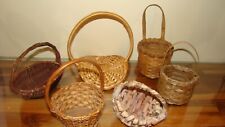
Basket Lot Woven Lot Various Kinds Small Vintage SIx $20.00
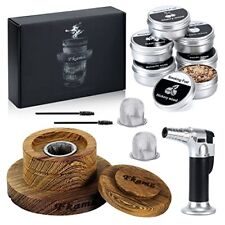
Cocktail Smoker Kit With Torch Six Kinds Of Wood Chips For Whiskey And Bourbon A $41.10
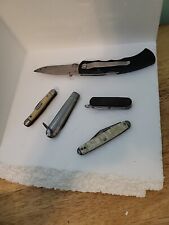
Lot Of Pocket Knife. Six Different Kinds. A13 $19.50
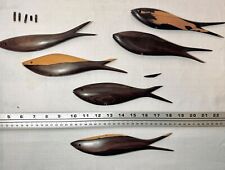
Carved Teak Fish; Damaged Sculpture In Pieces For Repair Six One Of A Kind $32.00

Diane Lane Kenny Rogers Six of a Kind Original 1980s Promo Photo $7.16
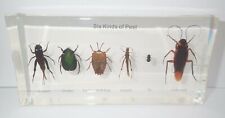
Six Kinds of Pest Insect Set in Clear Block Education Real Specimen $38.00

Six Kinds of Beneficial Insect Specimen Set in clear block Teaching Aid $38.00
|